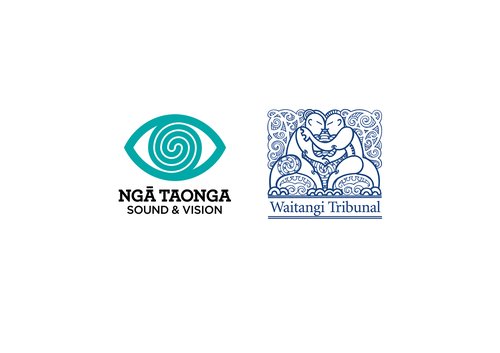
Years of historical Waitangi Tribunal recordings have been deposited with Ngā Taonga Sound & Vision, the audiovisual archive of Aotearoa New Zealand.
The announcement, made on World Digital Preservation Day, details the collection of magnetic media cassettes and video tapes from the Waitangi Tribunal’s audiovisual collection which were handed over to Ngā Taonga with a karakia and ceremony two weeks prior.
The ceremony was attended by Waitangi Tribunal member, Sir Professor Pou Temara, alongside the Chair of the Tribunal, Chief Judge Dr Caren Fox, as well as other members and Tribunal staff. Ngā Taonga was represented by Board Co-chair Lynell Tuffey-Huria, Chief Executive Honiana Love, and kaimahi.
The audio and visual recordings date back to the first hearing at Motunui in 1982 and span the many hearings up until the Tribunal moved to a born-digital format.
During the handover ceremony Sir Pou Temara spoke of the many recordings, which include recordings from kaumātua who have now passed on. He was heartened in the knowledge that their kōrero will be preserved for generations to come.
Steve Gunson, Pae Matua, Director of the Waitangi Tribunal, welcomed the partnership with Ngā Taonga by saying:
“We have been conscious for some time that we needed to digitise and preserve this hugely important record of Treaty history. Ngā Taonga are experts in digital preservation and are well placed to take care of these historically significant taonga.”
Ngā Taonga have long established practices to guide the collection and care of mātauranga Māori. The archive actively develops relationships with whānau, hapū, iwi and Māori organisations to ensure appropriate long-term care of, and access to, sound and moving image taonga.
Honiana Love, Tumu Whakarae, Chief Executive of Ngā Taonga Sound & Vision said:
“Ngā Taonga strives to set an example for other archives around the world in relation to the care and management of taonga that embody indigenous knowledge. Our TIAKINA framework seeks to make space for kaitiaki to speak on behalf of their mātauranga.”
The recordings will be digitised through Utaina, a multiyear crown-funded project to digitally preserve historical magnetic media in Aotearoa New Zealand.
Honiana Love said:
“There is a sense of urgency about preserving the Waitangi Tribunal hearings on magnetic tape, as without digital preservation, at-risk magnetic media content could be lost in less than a decade. The playback technology for these formats alone is on the verge of obsolescence.”
For Honiana, there is also a personal connection. Her father was the Director of the Waitangi Tribunal Unit from 1996 to 2003 and she herself has attended Tribunal hearings.
Chief Judge Fox noted that the approach Ngā Taonga takes in working with Māori was important in agreeing to handing over these taonga.
“We initially wanted the digitisation work done at the Tribunal given the cultural and historical significance of this collection, but that just wasn’t feasible. We then held several discussions with Ngā Taonga and were satisfied with their reassurances about the care of these taonga.”
Ngā Taonga have well-established procedures and protocols that allow Māori to exercise mana and control over how their taonga and mātauranga are accessed appropriately.”
The Chief Judge said the immediate need was to preserve the recordings, but that digitisation would eventually make it easier for these taonga to be made available to claimants and their descendants.
Ngā Taonga are planning to digitise the collection over the next year in time for the Waitangi Tribunal’s 50th anniversary in October 2025.
-ENDS-
For further information, please contact:
WaitangiTribunal@justice.govt.nz
Julie Warmington
Ngā Taonga Sound & Vision, Manager Marketing and Communications
Juliewarmington@ngataonga.org.nz
Photos available on request.
About Waitangi Tribunal
The Waitangi Tribunal was established by the Treaty of Waitangi Act 1975. The role of the Tribunal includes: inquiring into and making recommendations on well-founded claims; examining and reporting on proposed legislation; and making recommendations or determinations about Crown forest land, railways land; state-owned enterprise land, and land transferred to educational institutions. Through the establishment of the Tribunal. A legal process was paved through which Māori Treaty claims could be investigated. Contributing to the resolution of Treaty claims and reconciliation of outstanding issues between Māori and the Crown.
About Ngā Taonga
Ngā Taonga Sound & Vision is Aotearoa New Zealand’s audiovisual archive with a collection spanning more than 120 years of rich history. They hold a unique position as the only dedicated audiovisual archive capturing the history of New Zealand, told in sound and moving image. There are over 800,000 items in their care, dating back to 1895, and include film and television, sound and radio recordings. Ngā Taonga cares for the largest body of the historical recordings of te reo Māori and mātauranga Māori in the world. Operating as an independent charitable trust, it is governed by a Board of Trustees and funded predominantly by Manatū Taonga, the Ministry for Culture and Heritage; the Lottery Grants Board; and Te Māngai Pāho.